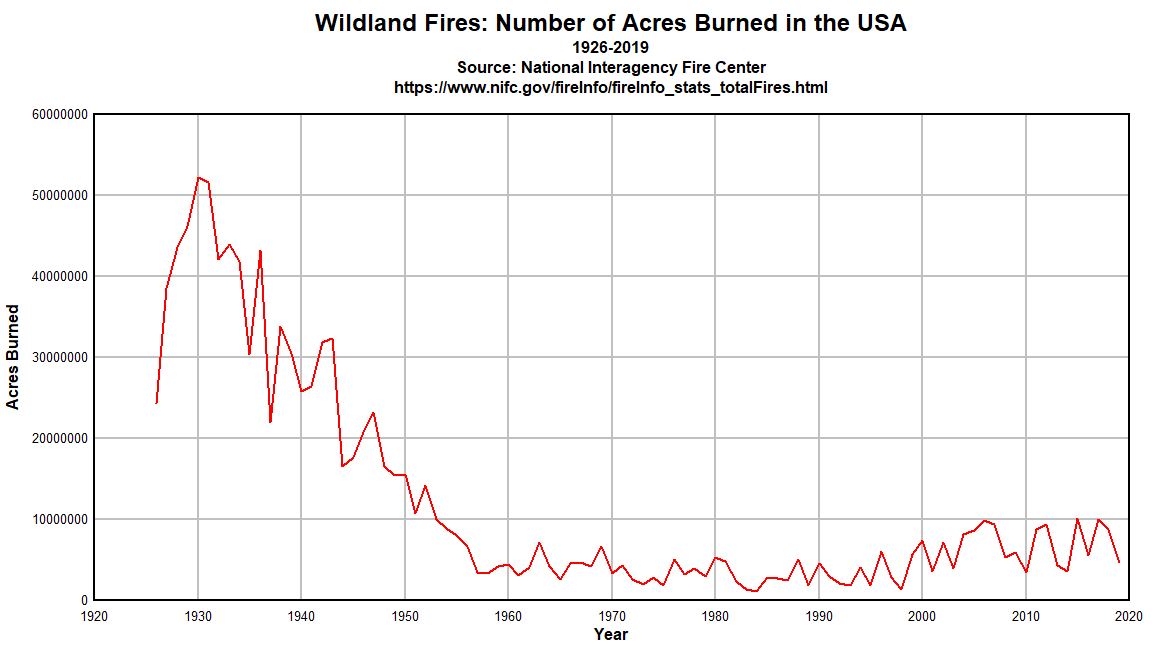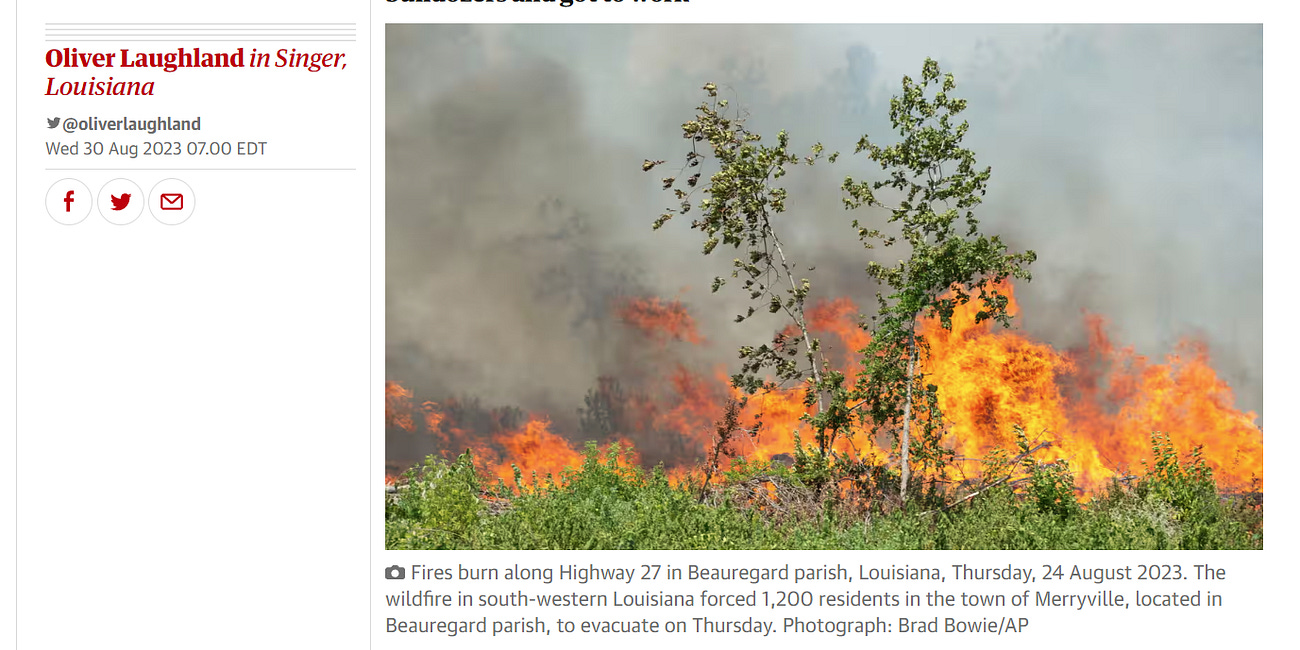New study shows that large wildfires are likely due to poor forest management, not climate change.
Multi-decadal fuel buildup in large California wildfire.
Fire history in North America…
Fire has been a natural and essential component of North American ecosystems for millennia. Before European colonization, Indigenous peoples actively used fire as a tool for various purposes, including enhancing habitat for game, facilitating travel, and promoting the growth of beneficial plant species. These deliberate burns helped shape the continent's landscapes, maintaining a balance of forest, savanna, and prairie ecosystems.
With European colonization and westward expansion in the USA during the 19th and 20th centuries, attitudes towards fire began to shift. Settlers viewed wildfires primarily as threats to property, timber resources, and lives. The catastrophic fires in the early 20th century, notably the Great Fire of 1910, which burned over three million acres in the Northern Rockies, solidified the perspective that fires were destructive forces that needed to be controlled. In response, aggressive fire suppression policies were adopted, led by agencies like the U.S. Forest Service. These policies aimed at extinguishing wildfires as quickly as possible, an approach often epitomized by the "10 a.m. policy," which set a goal of suppressing wildfires by 10 a.m. the day following their detection.
The long-term policy of fire suppression, while successful in reducing the number of fires in the short term, had several unintended consequences. Forests, particularly in the Western U.S., became overgrown with dense underbrush and dead wood. This accumulation of potential fuel made forests more susceptible to larger and more intense fires when they did ignite. Furthermore, the absence of regular, low-intensity fires in certain ecosystems, where fire had historically played a rejuvenating role, led to declines in biodiversity and changes in forest structure and composition.
By the late 20th century, the understanding of fire's ecological importance started to regain recognition. Ecologists and land managers began to see the negative impacts of strict fire suppression. They acknowledged that many North American ecosystems evolved with, and even depended on, regular fire disturbances. This led to a shift towards more nuanced fire management strategies, incorporating controlled burns and allowing some wildfires to burn under specific conditions. However, decades of fire suppression have left a legacy, with many Western U.S. forests now facing heightened risks from mega-fires that burn vast areas and are challenging to control.
Wildfire and climate change according to the IPCC…
The Intergovernmental Panel on Climate Change (IPCC) is the United Nations body responsible for assessing the science related to wildfires and climate change. Over the years, they've released various assessment reports that compile current knowledge on topics such as wildfires and their relationship to climate change.
The IPCC has provided the following insights on wildfires, fire weather, and climate change:
1. Observations:
Changes in wildfire frequency and intensity: There have been observed increases in wildfire frequency and intensity in certain regions, especially in the western United States, parts of Australia, and the Mediterranean. While certain regions have experienced more intense and frequent wildfires in recent years, global data show a decreasing trend in the total area burned annually. This decrease in the global burn area over the last few decades has been documented in various studies, and reported by NASA.
Changes in fire seasons: Although the decrease in global burn area, the IPCC claims that many regions are experiencing longer fire seasons, with some areas seeing nearly year-round fire potential.
2. Predictions:
Increased risk: The IPCC claims that as the global average temperature continues to rise, the conditions conducive to wildfires, such as increased temperatures and drought, are projected to increase.
Altered fire regimes: Not only will the frequency and intensity of wildfires likely increase, but the character of the fires may change. Some regions may see more frequent but smaller fires, while others may see less frequent but more intense and larger fires.
Interactions with other factors: To their credit the IPCC does state that while climate change is a driver of changes in wildfire risks, other factors like land use, forest management, invasive species, and human ignition sources can interact with climate factors, compounding or mitigating the risks.
3. Adaptation and Mitigation:
Better land management: The IPCC does acknowledge that adopting proactive land and forest management practices, like controlled burns and forest thinning, can reduce the buildup of flammable materials and lower the risk of intense wildfires.
Early detection and rapid response: Using technologies like satellites and sensors for early detection and deploying rapid response teams can help control fires before they grow large.
Community preparation: Building codes, land-use planning, and community education can play crucial roles in preparing communities for wildfires, reducing vulnerabilities, and ensuring swift evacuations when needed.
The links between climate change and wildfires are complex and can vary by region due to a multitude of factors. However, the general claim from the IPCC is that climate change, particularly the observed increases in global temperatures, is playing a role in exacerbating wildfire risks in many parts of the world.
Although the IPCC is careful to point out that currently there is ‘low confidence in direction of change’ in both drought and fire weather and the latest AR6 report (see table below) doesn’t expect the emergence of a signal in either of those variables through 2100.
However, this doesn’t stop the MSM and many prominent climate scientists from attempting to link climate change and anthropogenic GHG emissions to wildfires. I have written about those here:
Are wildfires in Canada a sign of climate change?
The role of fire in a forest ecosystem… Fires can have both positive and negative impacts on forest ecosystems, but when properly managed, they can contribute to the overall health and resilience of forests. Controlled or prescribed fires, as well as natural fires, play an important role in maintaining healthy forest ecosystems.
And here:
Update: A remarkably quiet fire season in the US...
This is an update to an article originally published on 08/09/2023 in response to claims that the anomalous fire season in Canada is fueled by GHG concentrations. Over the last few days, there has been renewed reporting on wildfires in the US with many outlets reporting on fires in Louisiana. Some headlines read…
What is driving an increase in wildfires in California?
Keep reading with a 7-day free trial
Subscribe to Irrational Fear to keep reading this post and get 7 days of free access to the full post archives.







